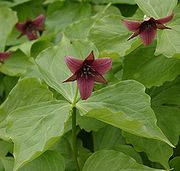
Trilliaceae
Encyclopedia

Botanical name
A botanical name is a formal scientific name conforming to the International Code of Botanical Nomenclature and, if it concerns a plant cultigen, the additional cultivar and/or Group epithets must conform to the International Code of Nomenclature for Cultivated Plants...
of a family
Family (biology)
In biological classification, family is* a taxonomic rank. Other well-known ranks are life, domain, kingdom, phylum, class, order, genus, and species, with family fitting between order and genus. As for the other well-known ranks, there is the option of an immediately lower rank, indicated by the...
of flowering plants. The family has been recognised as distinct since 1846 when it was recognized; this table http://www.goldsword.com/sfarmer/Trillium/TrilliaceaeHistory.pdf for a summarizes the placement of these taxa. The family has been recognized by taxonomists such as Takhtajan, Dahlgren, Thorne, and Watson & Dallwitz; other taxonomists have considered these plants to belong to the family Liliaceae
Liliaceae
The Liliaceae, or the lily family, is a family of monocotyledons in the order Liliales. Plants in this family have linear leaves, mostly with parallel veins but with several having net venation , and flower arranged in threes. Several have bulbs, while others have rhizomes...
. The APG II system
APG II system
The APG II system of plant classification is the second, now obsolete, version of a modern, mostly molecular-based, system of plant taxonomy that was published in April 2003 by the Angiosperm Phylogeny Group. It was a revision of the first APG system, published in 1998, and was superseded in 2009...
, of 2003 (unchanged from the APG system
APG system
The APG system of plant classification is the first, now obsolete, version of a modern, mostly molecular-based, system of plant taxonomy that was published in 1998 by the Angiosperm Phylogeny Group. It was superseded in 2003 by a revision, the APG II system, and then in 2009 by a further...
, of 1998), does not recognize such a family either and assigns the plants involved to family Melanthiaceae
Melanthiaceae
Melanthiaceae is a family of flowering perennial herbs in the Northern Hemisphere. The family has been recognized by relatively few taxonomists, and the circumscription has varied...
. One problem with this recognition is the lack of morphological synapomorphies for the family Melanthiaceae
Melanthiaceae
Melanthiaceae is a family of flowering perennial herbs in the Northern Hemisphere. The family has been recognized by relatively few taxonomists, and the circumscription has varied...
; this chart http://www.plantbio.uga.edu/~wendyz/Melanth%20family%20chart.html provides a summary of the characters in each of the major groups.
Nevertheless, some taxonomists still recognize a separate family Trilliaceae. The most important genus in North America is Trillium
Trillium
Trillium is a genus of about 40–50 species of spring ephemeral perennials, native to temperate regions of North America and Asia....
, and the taxonomy of that genus has always been controversial. To paraphrase what Steven Elliott
Stephen Elliott (botanist)
Stephen Elliott was an American legislator, banker, educator, and botanist who is today remembered for having written one of the most important works in American botany, A Sketch of the Botany of South-Carolina and Georgia.-Biography:Stephen Elliott was born in Beaufort, South Carolina on...
wrote of the genus Trillium in 1817,
- "this family is an interesting one. A whorl of leaves at the summit of a stem, supporting a single flower, it contains and conceals many species."
A recent treatment (Farmer and Schilling 2002) stated that the family Trilliaceae, which exhibits an arcto-tertiary distribution, comprises six genera. Three of these exhibit a wide distribution:
- ParisParis (genus)Paris is the botanical name of a genus of flowering plants. It consists of less than two dozen herbaceous plants: the best known species is Paris quadrifolia. The primary center of Paris diversity is China; the genus includes representatives native to Europe and Asia...
from Iceland to Japan, - Daiswa from eastern Asia, and
- Trillium from North America and eastern Asia
Three are monotypic, endemic genera:
- Trillidium govanianum, with a tepaloid inflorescence, from the Himalayan Mountains;
- Kinugasa japonica, with petaloid sepals, from Japan; and
- Pseudotrillium rivale, newly segregated, with spotted petals, from the Siskiyou Mountains of California and Oregon.
External links
- Susan Farmer's web pages on Trilliaceae and the genus Trillium
- Farmer & Schilling 2002 -- article in Systematic Botany on Trilliaceae
- Trilliaceae in L. Watson and M.J. Dallwitz (1992 onwards). The families of flowering plants: descriptions, illustrations, identification, information retrieval. Version: 3 May 2006. http://delta-intkey.com.
- links at CSDL, Texas
- history and placement of taxa in Trilliaceae
- http://www.plantbio.uga.edu/~wendyz/Melanth%20family%20chart.htmlmorphological characters of genera within MelanthiaceaeMelanthiaceaeMelanthiaceae is a family of flowering perennial herbs in the Northern Hemisphere. The family has been recognized by relatively few taxonomists, and the circumscription has varied...
sensu APG II]

